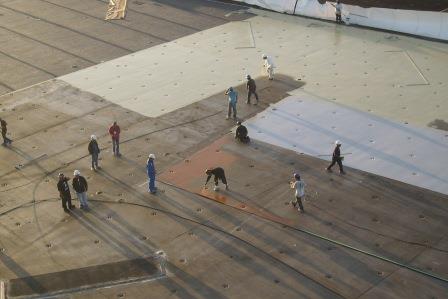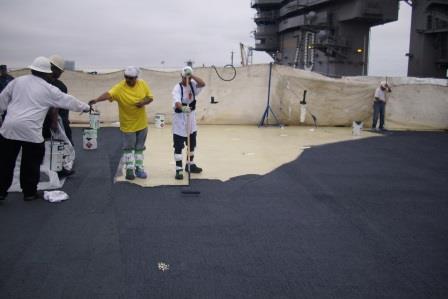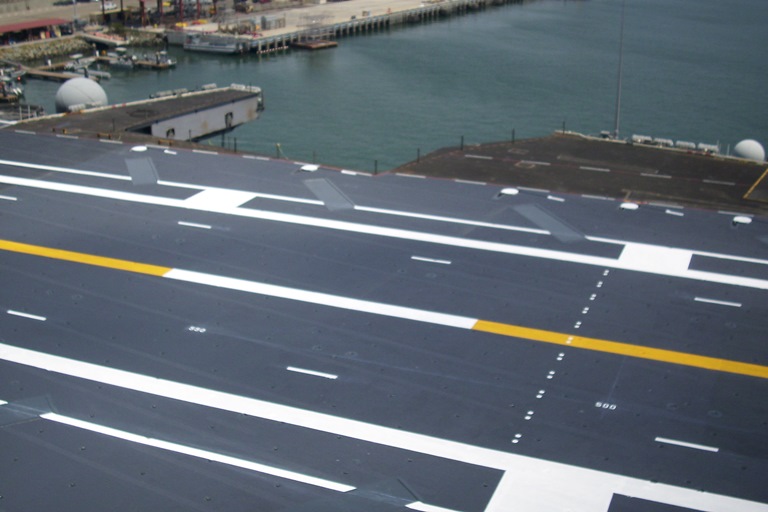Check out the feature article about the USS Carl Vinson
in the November 2014 issue of CoatingsPro here
Nonslip coatings are used throughout the construction industry for various safety-related reasons. On the USS Carl Vinson, nonslip coatings (aka non-skid per the Navy’s terminology) were crucial to the success of the flight deck.
Like most ships, the requirements for this aggressive high-tech safety feature have to meet the manufacturer’s ASTM F718: Standard Specification for Shipbuilders and Marine Paints and Coatings Product/Procedure Data Sheet. This specification gives required ranges by way of profile depth — wet film thickness and dry film thickness (minimums and maximums for both) — allowable application ambient conditions, and also recoat windows in order for this particular coating to ensure the maximum in life longevity. And because this anti-skid application was done on a naval vessel, the requirements were more stringent than they would have been on a civilian ship.
 Because this is a military vessel, South Bay was also under contractual obligations and requirements to meet Naval Sea Systems Command (NAVSEA) Standard Item 009-32: Cleaning and Painting Requirements, which covers all coatings maintenance on board military vessels. NAVSEA standard items are considered the governing documents that supersede all manufacturer requirements, including anti-skid coatings.
Because this is a military vessel, South Bay was also under contractual obligations and requirements to meet Naval Sea Systems Command (NAVSEA) Standard Item 009-32: Cleaning and Painting Requirements, which covers all coatings maintenance on board military vessels. NAVSEA standard items are considered the governing documents that supersede all manufacturer requirements, including anti-skid coatings.
Rapid-cure slip-resistant coatings use a complex coating system containing aggregates that help provide a slip-resistant deck in walking or traffic areas. On the USS Carl Vinson, the anti-skid coatings were used on the flight deck in particular. Anti-slip resistant coatings may also be used in areas that have a more complex design, such as a VLS (Vertical Launch System). Most rapid-cure slip-resistant coatings use abrasives at the following mix:
- Aluminum Oxide: average of 40–50 percent
- Barium Sulfate: 20–35 percent
- Epoxy Resin: 10–20 percent
There are also non-abrasive slip-resistant coatings, such as the 400-L series (the “L” means Limited), which may use non-abrasives such as glass, cork, or aluminum; these types of anti-skid coatings are generally used in the landing area on an aircraft carrier flight deck so as not to damage the arresting gear cables. On the USS Carl Vinson, South Bay contractors used a system by ITW American Safety Technologies, which also features MS-440-G, (the “G” means General). According to the coating’s technical bulletin, this 440-G Non-Skid is a “high solids, two-part, general purpose non-slip deck coating formulated with special epoxy resins and Kevlar aramid [by DuPont] to give maximum adhesion and abrasion resistance on aircraft carrier flight decks to provide non-slip  protection for aircraft, rolling equipment, and personnel.” It is a “fire retardant in the cured state,” and “because of its tenacious bond, rust will not creep under the coating if fractured.
protection for aircraft, rolling equipment, and personnel.” It is a “fire retardant in the cured state,” and “because of its tenacious bond, rust will not creep under the coating if fractured.
This anti-skid coating is resistant to fire and jet blasts, most acids, alkalis, solvents, grease, detergents, gasoline, jet fuels, and other hydraulic fluids. There are other resins used for anti-skid coatings, such as polyurethanes, and the Navy Research Lab (NRL) is currently working with manufacturers on polysiloxane slip-resistant coatings.
These nonslip coatings are a major safety feature on board our military naval vessels. In fact, according to NAVSEA Standard Item 009-32 paragraph 3.7, the flight deck area is considered a “critical coated area.” This means that working on this critical area requires that the contractor, per NAVSEA, “record and maintain in-process records in Coating QA [Quality Assurance] Tool Kit (CQATK), paperless QA program, or on QA Checklist Form Appendices as blasting, painting, nonskid, inspections, and tests are being accomplished.” NAVSEA Standard Item 009-32 goes into further detail for the application of the nonskid system, including Note (63), which reads:
“Nonskid shall be applied to within 2–3 inches [5–8 cm] of deck fittings and protrusions. Nonskid shall be applied to within 4–6 inches [10–15 cm] from coamings and deck edges. Areas underneath protrusions, such as stowage racks or fire stations that are normally found on hangar decks, or coaming areas of decks not subject to vehicle or aircraft movement, need not comply with the 4–6 inch [10–15 cm] rule for applying nonskid near deck edges.”
Overall, the proper application of approved anti-skid coatings is essential to the safety of the United States Navy’s flight decks and, therefore, the safety of our warfighters. Without the proper nonskid coatings on these vessels, our service members walking and landing on deck may be at risk.
For more information, contact: ITW Polymer Coatings, (215) 855-8450, www.itwcoatings.com, and NAVSEA, (202) 781-4123, www.navsea.navy.mil
